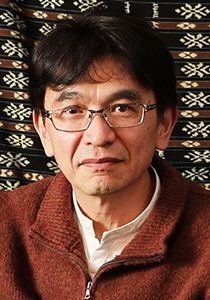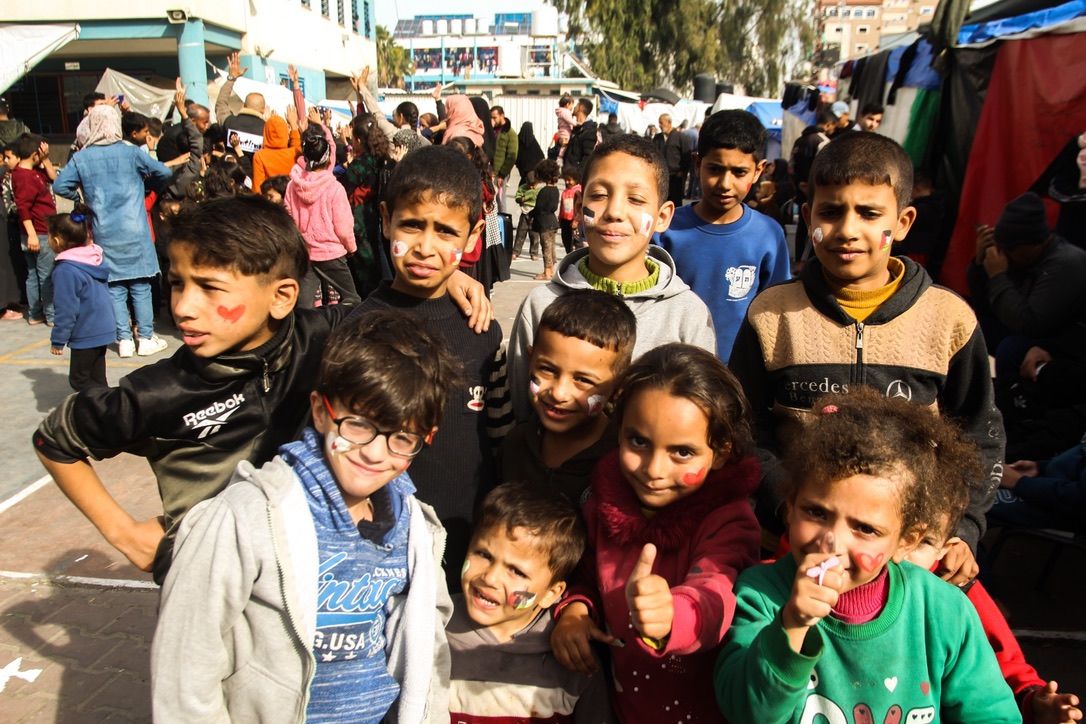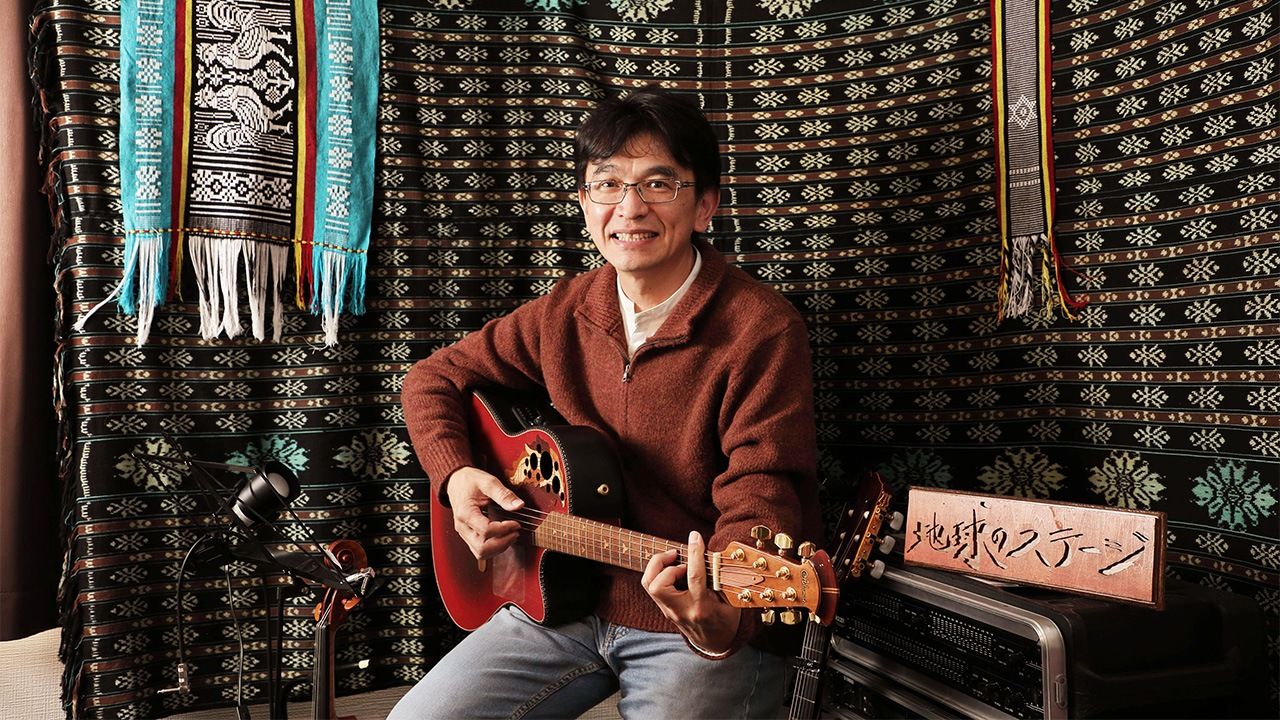
Kuwayama Norihiko: Bringing Post-Trauma Therapy to Warzones and Disaster Areas Around the World
People Society Work- English
- 日本語
- 简体字
- 繁體字
- Français
- Español
- العربية
- Русский
Friendship with Palestine
A photo uploaded in early January this year to the website of Kuwayama Norihiko’s NPO Frontline shows a group of children, their cheeks painted with hearts and Japanese flags, their smiling faces turned to the camera.
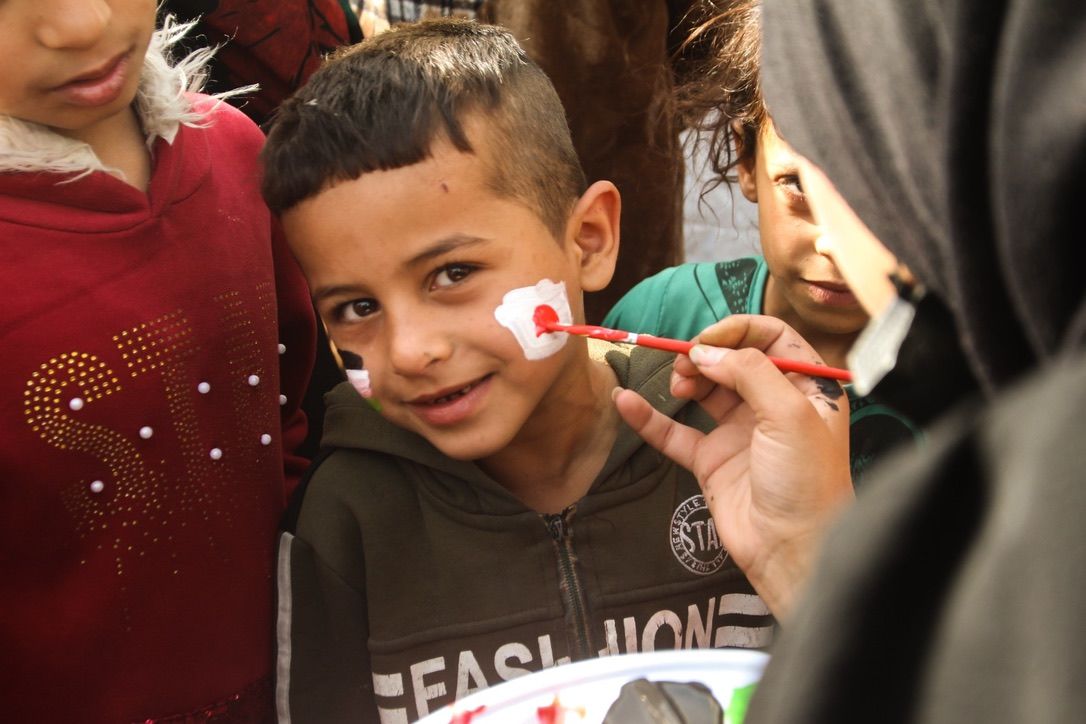
Children in Rafah, Gaza. (© Mohamed Mansour and Frontline)
The children were photographed in Rafah in the southern part of the Gaza Strip, painting their faces and sending a message of encouragement to people affected by the earthquake that devastated the Noto Peninsula in Ishikawa Prefecture on New Year’s Day 2024.
For many years, Kuwayama has been providing emergency medical assistance in conflict-ridden countries and disaster zones around the world. Since 2003, he has traveled to Palestine 45 times, working to bring treatment to people living in fear of missiles and shells and suffering from trauma and post-traumatic stress. On every trip, his mission has been to restore smiles to the faces of people traumatized by conflict and loss.
“There are people in Gaza who look on me as one of their family. My activities are not inspired by any noble aspiration for world peace or anything like that. Everything I do is driven by the same conviction: I can’t turn a blind eye to the suffering of people who are my friends and family.
“They sent those messages of encouragement as soon as they heard about the earthquake. They are people who know what it means to suffer. Palestinians can understand and empathize with the suffering of others even while being in a desperate situation themselves, with no guarantee for their own day-to-day safety.”
Communicating the Truth
Today, not even medical volunteers can enter the Gaza Strip, and emergency supplies are not getting through to those who need them. Kuwayama says the situation in Gaza is just about as bad as it could be.
“Since my first visit to Palestine, war has broken out five times. But this is by far the worst. Previously, people were mostly afraid of bombs. But this time there is nothing to eat, and no medicine. So, people are facing a triple fear, living under the threat of starvation and disease as well as all the bombs and shells.”
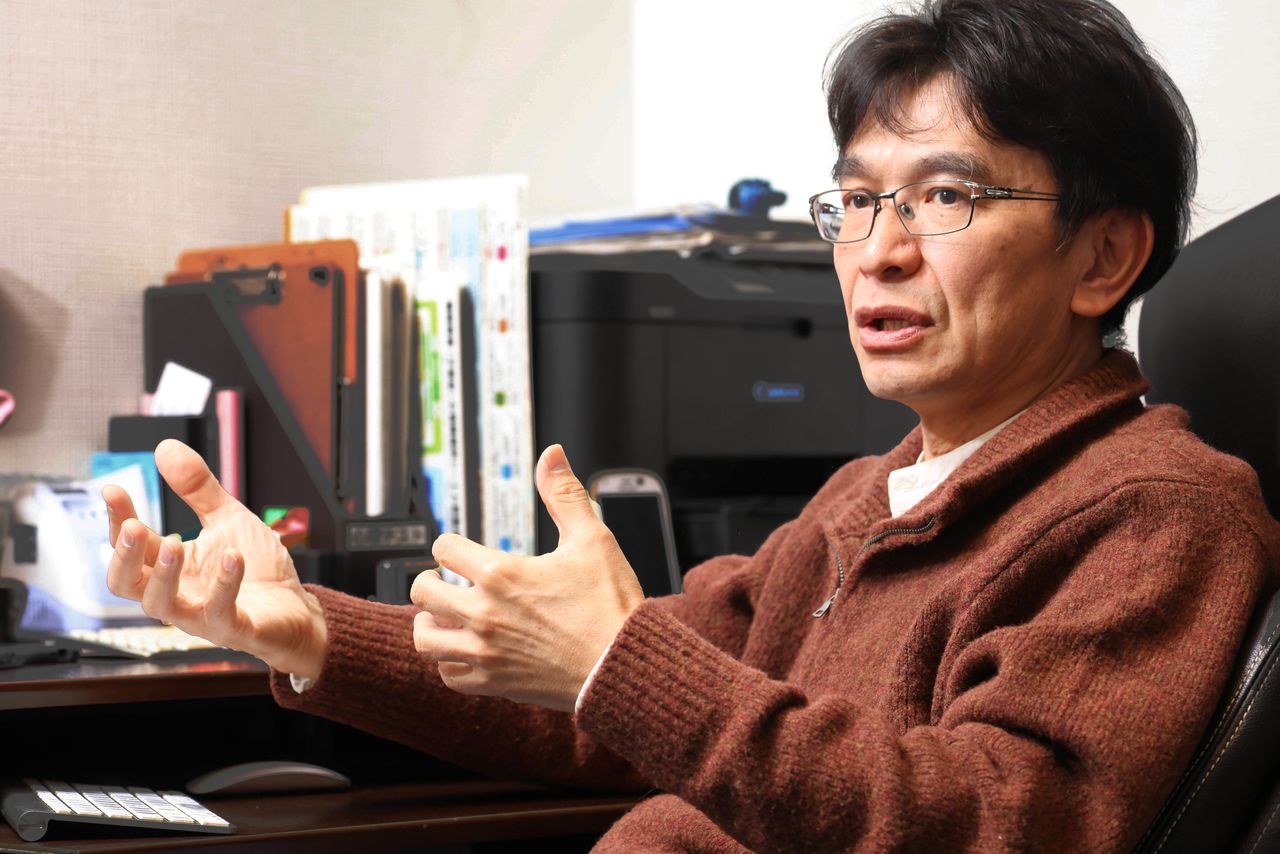
“People are facing a triple fear.” (© Hanai Tomoko)
Kuwayama has long worked on a psychosocial care project to support local children in Rafah, and trained local staff to carry on the work. Among them is 27-year-old Mohamed Mansour.
Kuwayama first met Mohamed when he was 13. After he asked local children to draw pictures, he noticed that Mohamed’s drawings used no colors. When he asked him why, he said: “There have been no colors in our town since the bombs came.”
He also harbored strong feelings of hatred and resentment. After psychosocial care, he went on to do a university degree in media studies and decided that the best path to justice was not to seek revenge, but to show people the truth. Since then, he has been taking photographs documenting the situation in Gaza and sending them to Kuwayama on an almost daily basis. It was Mohamed who sent the picture of the smiling children with their painted faces and message of encouragement for the earthquake victims in Japan.
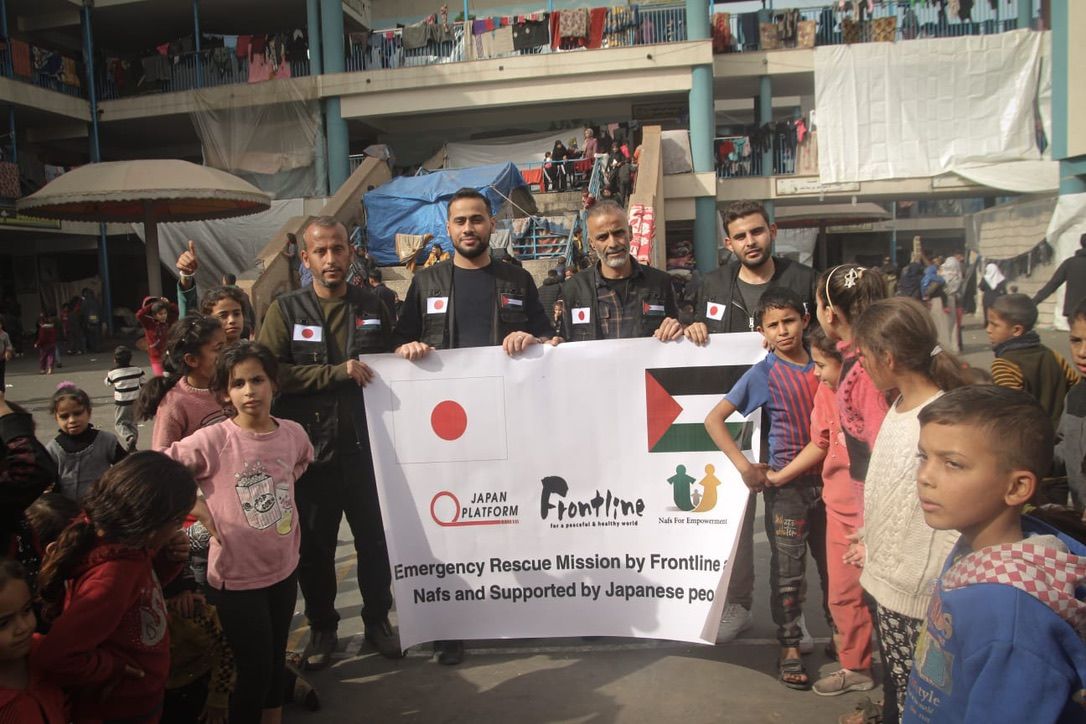
Local staff wearing jackets emblazoned with the Japanese flag and the Frontline logo. Mohamed Mansour is shown second from the left. (© Frontline)
Kuwayama says there are now people like Mohamed who can provide ongoing care in all the places where the NPO is active.
Preserving Memories of the Tōhoku Tsunami
We met Kuwayama in mid-January, when he had just returned from a visit to Wajima in Ishikawa Prefecture, one of the areas worst hit by the New Year’s Day earthquake. Since visiting evacuation centers and listening to people speak of their experiences, he says he has been considering the approach to PTSD care that he will use on future visits.
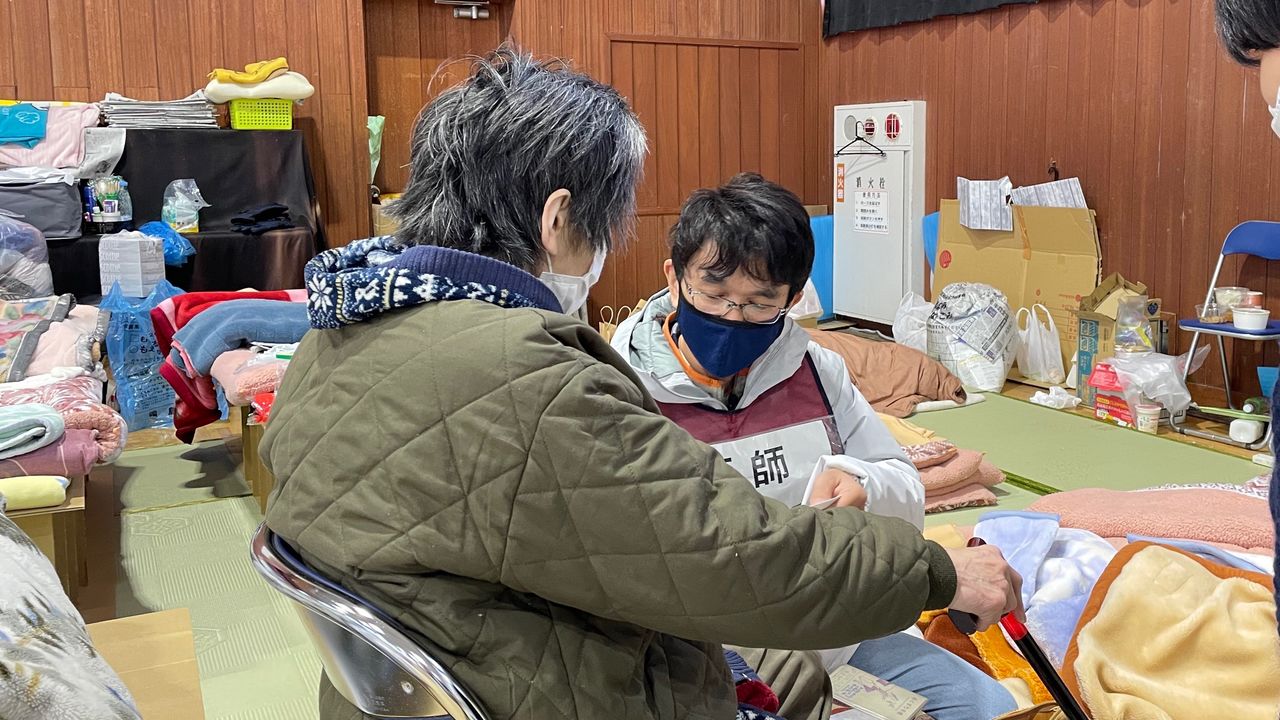
Kuwayama meeting those affected by the Noto Peninsula Earthquake. (© Frontline)
Kuwayama provided psychosocial care for numerous people after the devastating earthquake and tsunami that affected large parts of the Tōhoku region in March 2011. He was directly impacted by the earthquake himself, having opened a clinic in the Yuriage district of Natori two years before the disaster struck.
“Fortunately, the clinic itself escaped being swallowed up in the tsunami, but the whole surrounding area was buried under black mud. I lost several people who were precious to me, including close friends.”
Kuwayama started offering treatment the day after the disaster. As he listened to people talk—often people who had lost their entire families, and were struggling with survivor’s guilt—he found tears rolling down his cheeks. The sight of the doctor’s tears seemed to have a strange power to unblock self-protective barriers and open the floodgates in the traumatized hearts of disaster victims.
“In many cases, people started speaking with blank expressions on their faces. I think the sight of me crying changed the situation. It’s almost as if they thought, ‘If the doctor’s crying, it’s all right for me to cry too.’ Gradually, their features took on a more natural expression. To overcome trauma, it’s important not to bottle it all up. You need to have the strength to confront honestly what has happened, and sublimate those experiences into a narrative that you can put into words and communicate to society.”
Many of the people who received trauma counseling from Kuwayama have gone on to relate to others their own experiences of the disaster. One of these is Tanno Yūko, who lost her son, a junior high school student, in the tsunami, as well as everything that might have reminded her of their lives together. In the immediate aftermath, she lost all hope and will to live. Inspired by her meeting with Kuwayama, she resolved to share her experiences in the hope that they might help others in a similar situation.
The year after the disaster, with support cooperation from Kuwayama, Tanno was one of the founders of the “Memories of Yuriage” memorial. Dedicated to local people’s aspirations for post-tsunami reconstruction, this small museum opened on the grounds of the Yuriage Junior High School—which moved to new premises on an adjacent site in 2015—where Tanno’s son was one of 14 of the pupils lost their lives in the tsunami. Tanno still works as a volunteer there now, passing on the lessons and memories of the disaster and its aftermath.
Early Encounters with the Outside World
Kuwayama was born in Takayama in Gifu Prefecture. From an early age, he found it difficult to make friends and felt like an awkward outsider. When he was 14, he started learning the guitar and violin, but didn’t make much progress. He retreated further into his own shell. In high school, he resolved to make a new start and started to play in a band, but still struggled to fit in. One day, his older brother told him: “You’re not all there. You’ve got a screw loose.” Kuwayama found himself convinced. “He’s right: there must be something wrong with me,” he thought. It was this sense that there was something not quite right that made him decide to study psychiatry, in an attempt to “fix” himself.
As a medical student, he set off backpacking around the world and had encounters with all kinds of people. Shortly after qualifying as a doctor, he met a young girl in Manila whose grandmother was suffering from serious conjunctivitis. When he gave her the eye medicine that he happened to have with him, the girl was overcome with gratitude. This experience made him realize that it is sometimes possible to make a difference through even small acts of kindness.
While working as a hospital doctor in Yamagata Prefecture, he became involved in medical support in conflict-torn countries and met numerous people suffering from trauma in camps for Cambodian refugees, in Iraq during the Gulf War, and in Somalia. In 1994, he decided to acquire the skills he needed to provide a higher level of care, and traveled to Norway to study psychosocial care at Oslo University. The following year, he gained hands-on experience during the conflict in the former Yugoslavia.
A Different Kind of Support
In 2002, he launched Frontline, aiming to provide assistance that differed from that provided by international organizations and government agencies.
“Advocacy and policy recommendations can be left to the big public sector organizations. I wanted to get closer to people who had been born and grown up in the country, and help give them the strength to live fulfilling lives in line with their own dreams and wishes.”
Since then, he has provided emergency medical assistance and psychosocial care therapy in disaster areas and warzones around the world. As well as Gaza and other conflict areas, he has provided counseling and therapy after major earthquakes and tsunamis in Iran, Sri Lanka, Indonesia, and Pakistan, as well as to refugees and others affected by regional conflicts in Jordan, Iraq, and South Sudan. Recently his organization also started activities in Ukraine. The group’s activities are not limited to medical assistance. The NPO has provided educational help to the Pa’O minority group in Myanmar and is also involved with maternal and child health support in East Timor.
“Theoretically, I am the one offering help. But the reality is different. Often, I am the one who is inspired and encouraged by the people I meet and the courage they display in difficult circumstances—their appetite for life, and their kindness to others. They make me feel foolish for worrying about little things in my life in Japan. This naturally leads to feelings of affection, and I come to think of them as family. And if a family member is struggling, it is only natural to want to offer support. That’s what anyone would feel. And that is the origin of everything I do.”
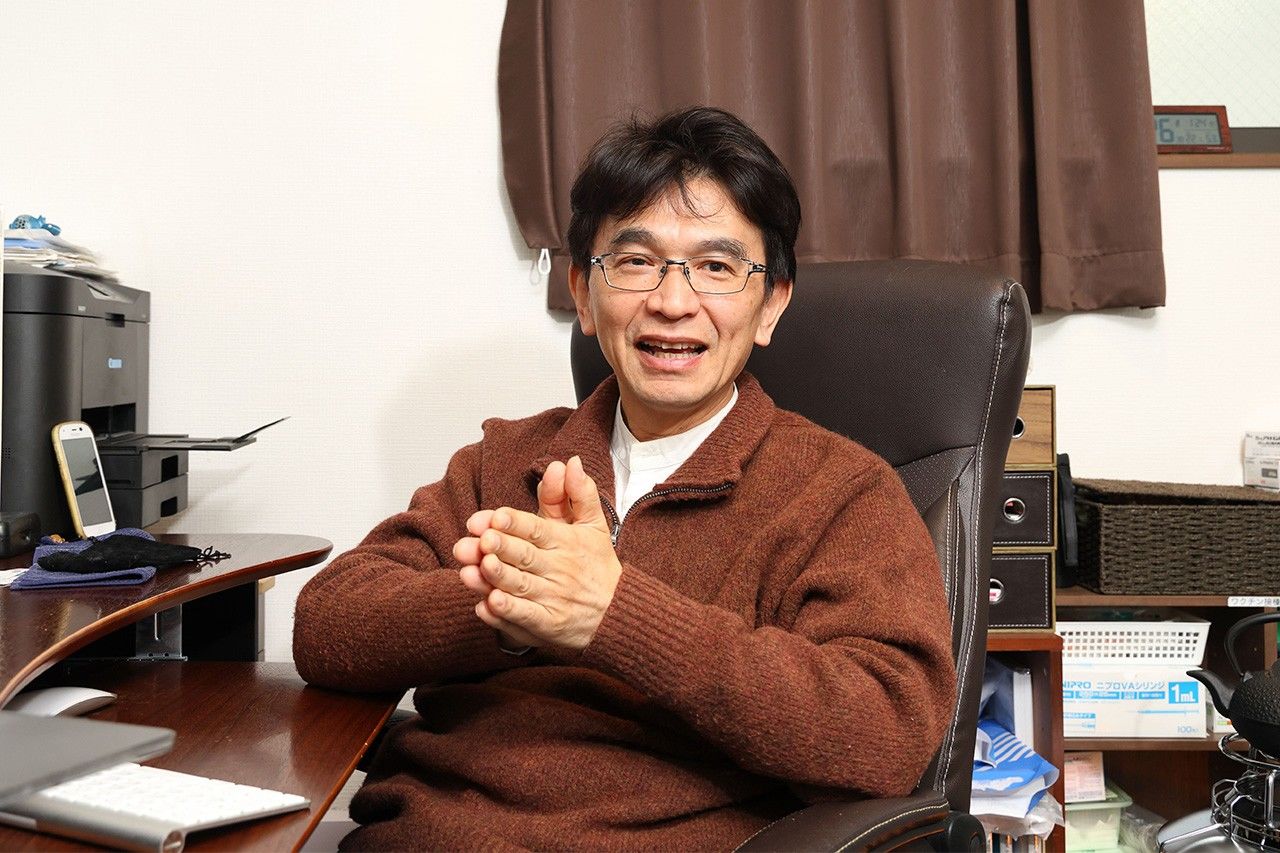
“Often, I am the one who is inspired and encouraged by the people I meet and the courage they display in difficult circumstances.” (© Hanai Tomoko)
Reaching Children Through Music and Video
As “Earth Stage,” the NPO also runs events at schools throughout Japan, introducing children to the situation in the countries where it operates, through video footage and song. The person responsible for bringing the message across through his music is Kuwayama himself.
He has already given more than 4,000 performances, dating back to 1996, before he founded the NPO. At one time he was giving more than 250 performances a year, but this has fallen dramatically to around 50 performances a year since the COVID pandemic.
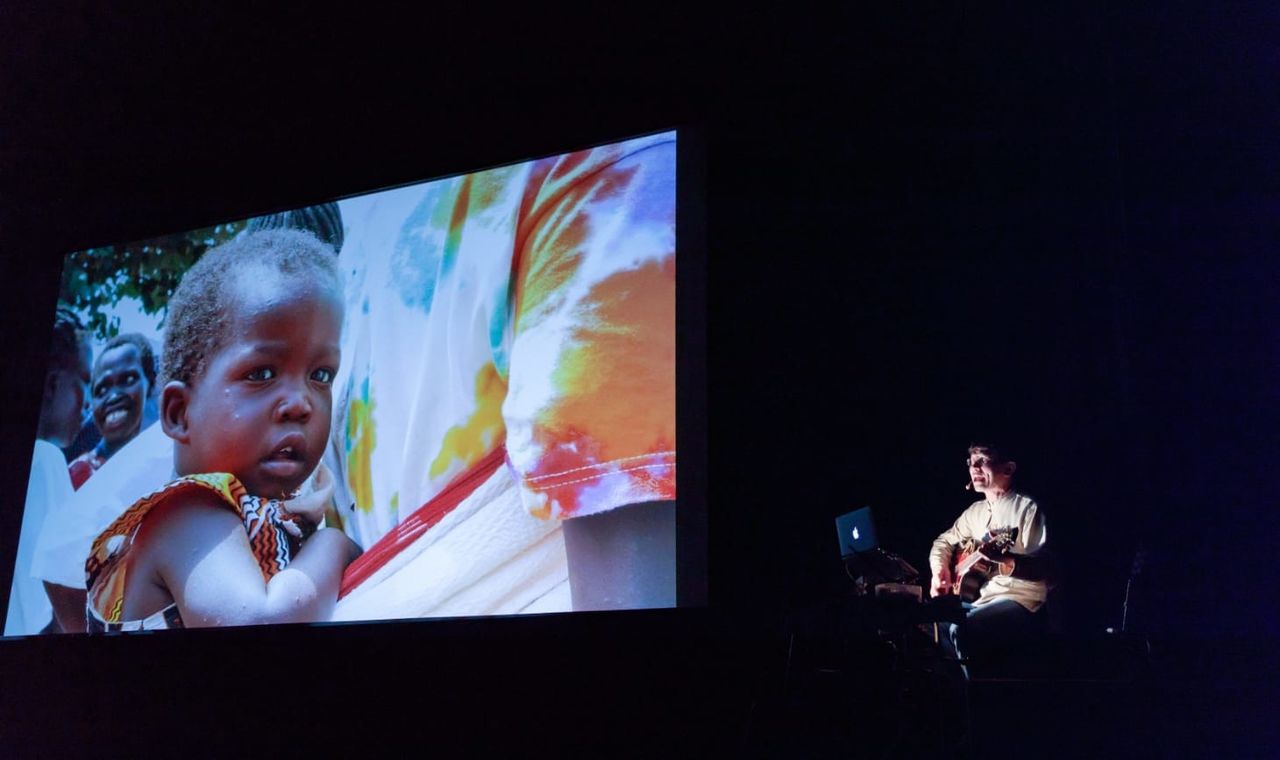
Through an event with live music, video, and slides, Kuwayama conveys the resolution of people living in harsh circumstances. (© Frontline)
“The world is undergoing dramatic transformations, and I think it’s a shame that schools in Japan are still hesitant to put on events because of the impact of COVID. I want to show children the reality of what is happening through the show and let them see what is happening in Gaza, in Ukraine, or in the Noto Peninsula, and encourage them to think about diversity, peace, mental and psychological strength, and their connections with other people. Sometimes I hear that one of the children who saw me perform at their school grew up to become a doctor or is now working for an international aid organization. Those are the times when I really feel it has all been worthwhile and I’m glad that I continued with my activities for all these years.”
The Need to Confront Trauma
In 2016, he moved from Natori to Ebina in Kanagawa Prefecture, where he opened the Ebina Kokoro no Clinic. At the moment, the clinic focuses on providing care to children who do not attend school for psychological reasons. The clinic is often approached by local government and the police, and provides psychosocial care to victims of crime and their families. Kuwayama also provided therapy to people affected by the dreadful 2016 knife attack at Tsukui Yamayurien, a care facility for people with mental disabilities in Sagamihara, in which 19 people were killed.
Psychosocial care is a method based on international standards that is widely used around the world in psychological first aid and treatment for PTSD. It is a group therapy approach in which people talk about their experiences. In workshops, people confront trauma by giving expression to difficult memories and associated emotions through creative activities that include drawing, clay modeling, filmmaking, or putting on a drama, and sharing these activities with peers and people from the local community. Through this process, people come to see that their own painful experiences can be helpful to others, and this helps them to escape from their psychological isolation and reconnect with the community.
This approach is rooted in human nature and natural healing power. “When a person undergoes a painful experience, after a certain amount of time has passed the person wants to talk about it with someone. When that becomes possible, people often feel a natural desire to use their experience in a way that will be useful for others in the community.”
Kuwayama admits that this approach has not yet become widespread in Japan. Part of the reason, he says, has to do with particular prejudices about trauma and suffering that remain prevalent in the culture.
“There’s a strong feeling in this country that you should let things lie. Don’t stir up the past or prod too closely around difficult subjects and traumatic memories. Leave it to time and hope that people forget. But trauma isn’t something that you can erase, and in fact it is important to understand that it is not something you should erase or ignore. By facing up to what has happened, together with others, people can turn those experiences into a source of growth and transformation. My hope is that Japanese society will become one in which people become better equipped to confront trauma and talk openly about their experiences.”
Kuwayama has also started training activities to nurture the next generation of providers of psychosocial counseling therapy care both in Japan and other countries, including those where the NPO clinic has provided post-trauma assistance in the past. He recently turned 60, but says he wants to keep connected to the wider world and contribute for as long as he can.
“Every time I visit a place, I incur a debt to people through the help and encouragement they give me. I try to repay that by traveling to the next place when another disaster or conflict occurs. The people there help me again, and the cycle continues. I have built up a huge accumulation of debt and gratitude, which I could never repay even if I spend the rest of my life trying.”
(Originally written in Japanese and published on February 27, 2024. Text by Itakura Kimie of Nippon.com based on an interview by journalist Yoshii Taeko. Banner photo: At the Ebina Kokoro no Clinic. © Hanai Tomoko.)
disaster Great East Japan Earthquake Palestine Noto Peninsula conflict
